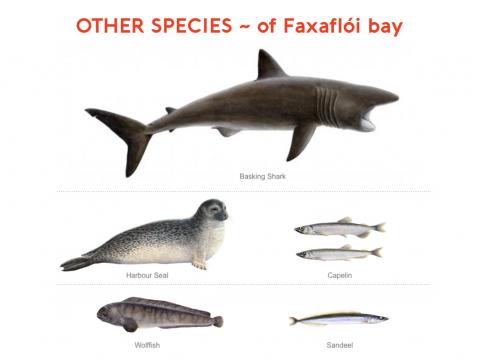
On our whale watching tours we often encounter other species than whales. The various seabirds, seals and sharks bring surely added value to our tours.
Other Species:
-
Image
 Read more...
Read more...We are seeing more of these over the last couple of years as the water temperatures rise. They get their name by the way they are moving very close to the water surface (basking in the sun) however they are a plankton feeder and this is where the food is.
-
Image
 Read more...
Read more...Capelin is a cold water species and the most ecologically important fish in Icelandic waters. It links the food web between zooplankton and larger fish or baleen whales. Comprising 40% of a cods diet, for example. The capelin spawning grounds are in the South and Southwest of Iceland. The larvae then drift to North Iceland towards Greenland.
-
Image
 Read more...
Read more...Grey seals are generally distinguished from harbour seal by their straight head and fewer spots. Males are darker and larger than the females who tend to be a silver, grey or brown in color. Grey seals and harbour seals are the only seals that have been reported breeding in Icelandic waters.
-
Image
 Read more...
Read more...Seals and Sea lions are collectively called Pinnipeds. Harbour Seals are the most abundant in Iceland and are frequently encountered on Akurey (puffin colony). There has been 7 species of seals recorded in Icelandic waters but only two of these species breed here; the Harbour Seal and Grey Seal.
-
Image
 Read more...
Read more...There are three types of sandeels found in Icelandic waters Ammodytes tobianus (Lesser Sandeel; Sandsíli), Ammodytes marinus (Lesser Sandeel; Marsíli) and Hyperoplus lanceolatus (Greater Sandeel; Trönusíli).
-
Image
 Read more...
Read more...The wolfish is a priced catch to recreational and commercial fishermen alike. They have very strong jaws and teeth to enable them to crush shellfish and echinoderms (sea urchins, starfish, sea cucumbers). Unlike most other fish the Wolffish (usually the males) will guard its eggs until they are hatched. When this is done they will all migrate to other areas around Iceland.




